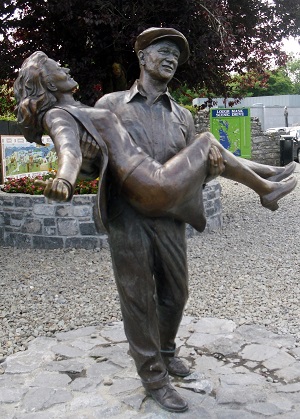 by Mark Rode in Cong. The romantic comedy-drama film, The Quiet Man, shot in and around Cong, County Mayo, Ireland, during 1951 and released in 1952, became one of the most popular films ever made. It was directed by John Ford, for which he won an Oscar, and starred Ireland’s first great Hollywood film star, Maureen O'Hara (1920-2015), together with John Wayne and Barry Fitzgerald. The Quiet Man received seven Academy Award nominations in a very competitive year. A second Oscar was won by Winton C. Hoch and Archie Stout for their superb colour cinematography. The excellent screen play was written by Frank Nugent, for which he received the Academy Award nomination. Ford was chosen by the Directors’ Guild of America for their top award in 1952 for his work on The Quiet Man. Nugent won the Writers’ Guild of America Award for ‘best written American comedy’ in 1953 for The Quiet Man. The film won several other awards. Its plot was based on a 1933 short story, ‘Green Rushes’, written by Kerry-born Maurice Walsh, set in Ireland of the 1920s. John Wayne plays Seán Thornton, a local returned from the Unites States of America after an absence of 15 years, where he became a noted boxer under the name of Tiger Enright. A quiet man who rarely talked about himself, he reclaims his native homestead and falls in love with Maureen O’Hara as the feisty Mary Kate Danaher. A loving relationship develops between Seán and Mary Kate, despite the efforts of her cunning brother, Red Will Danaher (Victor McLaglen). However, the film has a happy ending. In succinct conclusions about The Quiet Man film, Des McHale in A Complete Guide to The Quiet Man (2000; Belfast: Appletree Press) states (p. 257): John Ford was one of the cinema’s greatest directors, if not the greatest. The electric chemistry between Wayne and O’Hara is one of Hollywood’s greatest platonic love stories, and Ford’s stock company lent every ounce of support and experience that was necessary; Barry Fitzgerald stole the show and McLaglen was superb; Nugent’s screenplay based on Maurice Walsh’s original story was masterly, and Hoch and Stout’s cinematography quite magnificent. Throw in the Irish Players, the incomparable scenery of the West of Ireland and the wholehearted enthusiasm and cooperation of the people of Cong, Cross, the Neale and Clifden, and the ingredients are complete. The Quiet Man Cottage Museum, opened in 1994 by Gerry and Margaret Collins, is a replica of the house ‘White O’ Morn’ seen in the film, with the four poster bed, table and chairs and many other exhibits from various scenes. The museum also contains many other items of interest. Guided tours of the stunning scenery in the film and other sites around Cong can be accessed from the museum. A visit is a must for all admirers of the famous film. (www.quietman.com) A sculpture with bronze figures of John Wayne and Maureen O’Hara, Thornton was unveiled in Cong in 2013, the work of figurative sculptor, Mark Rode. Bernard O'Hara's latest book entitled Killasser: Heritage of a Mayo Parish is now on sale in the USA and UK as a paperback book at amazon.com, amazon.co.uk or Barnes and Noble It is also available as an eBook from the Apple iBookstore (for reading on iPad and iPhone), from Amazon.com and Amazon.co.uk (Kindle & Kindle Fire) and from Barnesandnoble.com (Nook tablet and eReader). An earlier publication, a concise biography of Michael Davitt, entitled Davitt by Bernard O’Hara published in 2006 by Mayo County Council , is now available as Davitt: Irish Patriot and Father of the Land League by Bernard O’Hara, which was published in the USA by Tudor Gate Press (www.tudorgatepress.com) and is available from amazon.com and amazon.co.uk. It can be obtained as an eBook from the Apple iBookstore (for reading on iPad and iPhone), from Amazon.com and Amazon.co.uk (Kindle & Kindle Fire) and from Barnesandnoble.com (Nook tablet and eReader). |